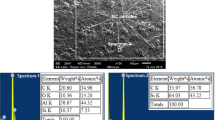Abstract
The application of response surface methodology was highlighted to predict and optimize the percentage of dilution of iron-based hardfaced surface produced by the PTA (plasma transferred arc welding) process. The experiments were conducted based on five-factor five-level central composite rotatable design with full replication technique and a mathematical model was developed using response surface methodology. Furthermore, the response surface methodology was also used to optimize the process parameters that yielded the lowest percentage of dilution.
Similar content being viewed by others
References
Budinski Kenneth G. Surface Engineering for Wear Resistance [M]. New York, Prentice-Hall Inc, 1988.
Wu Weite, Wu Lung-Tien. The Wear Behavior Between Hard-facing Materials [J]. Metallurgical and Materials Transactions, 1996, 27A(11): 3639.
Kumar S, Mondal D P, Khaira H K, et al. Improvement in High Stress Abrasive Wear Property of Steel by Hardfacing [J]. Journal of Materials Engineering and Performance, 1999, 8(6): 711.
Nadkarni S V. Modern Arc Welding Technology [M]. New Delhi: Oxford and IBH Publishing Co Pvt Ltd, 1996.
Gatto A, Bassoli E, Fornari M. Plasma Transferred Arc Deposition of Powdered High Performances Alloys: Process Parameters Optimization as a Function of Alloy and Geometrical Configuration [J]. Surface and Coatings Technology, 2004, 187(2–3): 265.
d’Oliveira A S C M, Vilar R, Feder C G. High Temperature Behaviour of Plasma Transferred Arc and Laser Co-Based Alloy Coatings [J]. Applied Surface Science, 2002, 201(30): 154.
Gurumoorthy K. Microstructural Aspects of Plasma Transferred Arc Surfaced Ni-Based Hardfacing Alloy [J]. Materials Science and Engineering, 2007, 456(15): 11.
Grainger S. Engineering Coatings—Design and Application [M]. 1st ed. Cambridge: Abington Publishing, 1989.
Subramaniam S, White D R, Jones J E, et al. Experimental Approach to Selection of Pulsing Parameters in Pulsed GMAW [J]. Welding Journal, 1999, 78(5): 166s.
Allen T T, Richardson R W, Tagliabue D P, et al. Statistical Process Design for Robotic GMA Welding of Sheet Metal [J]. Welding Journal, 2002, 81(5): 69s.
Murugan N, Parmer R S. Stainless Steel Cladding Deposited by Automatic Gas Metal Arc Welding [J]. Welding Journal, 1997, 76(10): 391s.
Marimuthu K, Murugan N. Prediction and Optimization of Weld Bead Geometry of PTA Hardfaced Valve Seat Rings [J]. Surface Engineering, 2003, 19(1): 143.
Bourithis L, Papadimitriou G D. Synthesizing a Class “M” High Speed Steel on the Surface of a Plain Steel Using the Plasma Transferred Arc (PTA) Alloying Technique: Micro-structure and Wear Properties [J]. Materials Science and Engineering, 2003, A361(1–2): 165.
Balasubramanian V, Varahamoorthy R, Ramachandran C S, et al. Selection of Welding Process for Hardfacing on Carbon Steels Based on Quantitative and Qualitative Factors [J]. The International Journal of Advanced Manufacturing Technology, 10. 1007/s00170-008-1406-8.
Gunaraj V, Murugan N. Application of Response Surface Methodology for Predicting Weld Bead Quality in Submerged Arc Welding of Pipes [J] Journal of Materials Processing Technology, 1999, 88(1): 266.
Montgomery D C. Design and Analysis of Experiments [M]. New York, John Wiley and Sons, 1991.
Miller I, Freund J E, Johnson. Probability and Statistics for Engineers [M]. New Delhi: Prentice of Hall of India Pvt Ltd, 1999.
Lin Bor-Tsuen, Jean Ming-Der, Chou Jyh-Homg. Using Response Surface Methodology for Optimizing Deposited Partially Stabilized Zirconia in Plasma Spraying [J]. Applied Surface Science, 2007, 253(6): 3254.
Benyounis K Y, Olabi A G. Optimization of Different Welding Processes Using Statistical and Numerical Approaches—A Reference Guide [J]. Advances in Engineering Software, 2008, 39(6): 483.
Montgomery D C. Design and Analysis of Experiments 3 [M]. New York, John Wiley, 2001.
Kumar S, Kumar P, Shan H S. Effect of Evaporative Casting Process Parameters on the Surface Roughness of Al-7% Si Alloy Castings [J]. Material Processing Technology, 2007, 182 (1): 615.
Öktem H, Erzurumlu T, Kurtaran H. Application of Response Surface Methodology in the Optimization of Cutting Conditions for Surface Roughness [J]. Journal of Materials Processing Technology, 2005, 170(1–2): 11.
Tien Chuen-Lin, Lin Shane-Wen. Optimization of Process Parameters of Titanium Dioxide Films by Response Surfaces Methodology [J]. Optics Communications, 2006, 266(2): 574.
Author information
Authors and Affiliations
Corresponding author
Rights and permissions
About this article
Cite this article
Balasubramanian, V., Lakshminarayanan, A.K., Varahamoorthy, R. et al. Application of Response Surface Methodolody to Prediction of Dilution in Plasma Transferred Arc Hardfacing of Stainless Steel on Carbon Steel. J. Iron Steel Res. Int. 16, 44–53 (2009). https://doi.org/10.1016/S1006-706X(09)60009-1
Revised:
Published:
Issue Date:
DOI: https://doi.org/10.1016/S1006-706X(09)60009-1




